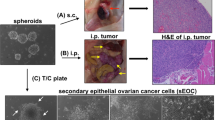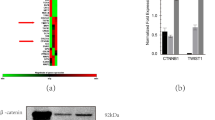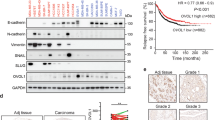Abstract
The majority of ovarian cancers (OCs) arise from the ovarian surface epithelium (OSE). Proliferation of the OSE can be regulated by a number of autocrine and paracrine factors, including transforming growth factor beta (TGFβ). Defects in the TGFβ signaling pathway have been implicated in a number of cancers, including ovarian. We previously found that the TGFβ signaling pathway is intact and functional in primary human OC cells, and that these cells stop growing in response to TGFβ. Ovarian cancer cells in vivo are exposed to TGFβ, yet continue to proliferate, therefore, mechanisms must exist to inhibit TGFβ signaling contributing to uncontrolled cellular proliferation. Numerous signaling pathways converge with the TGFβ pathway to modulate its effects, including signaling induced by epidermal growth factor (EGF). We hypothesized that EGF can modulate TGFβ signaling and contribute to uncontrolled cellular proliferation of OC cells. Our results show that EGF abrogates the antiproliferative effect of TGFβ. EGF does not modulate TGFβ signaling by inhibiting receptor-activated Smad (R-Smad) phosphorylation or nuclear translocation. Rather, EGF decreases TGFβ-induced mRNA expression of the cell cycle regulator, p15INK4B, contributing to decreased sensitivity of OC cells to the antiproliferative effect of TGFβ.
This is a preview of subscription content, access via your institution
Access options
Subscribe to this journal
Receive 50 print issues and online access
$259.00 per year
only $5.18 per issue
Buy this article
- Purchase on Springer Link
- Instant access to full article PDF
Prices may be subject to local taxes which are calculated during checkout





Similar content being viewed by others

References
Afrakhte M, Moren A, Jossan S, Itoh S, Sampath K, Westermark B, Heldin CH, Heldin NE and ten Dijke P . (1998). Biochem. Biophys. Res. Commun., 249, 505–511.
Auersperg N, Wong AS, Choi KC, Kang SK and Leung PC . (2001). Endocr. Rev., 22, 255–288.
Berchuk A, Rodriguez G, Olt G, Whitaker R, Boente MP, Arrick BA, Clarke-Pearson DL and Bast RC . (1992). Am. J. Obstetr. Gynecol., 166, 676–684.
Chen T, Triplett J, Dehner B, Hurst B, Colligan B, Pemberton J, Graff JR and Carter JH . (2001). Cancer Res., 61, 4679–4682.
Daly M and Obrams GI . (1998). Sem. Oncol., 25, 255–264.
de Caestecker MP, Parks WT, Frank CJ, Castagnino P, Bottaro DP, Roberts AB and Lechleider RJ . (1998). Genes Dev., 12, 1587–1592.
Dunfield LD, Campbell Dwyer EJ and Nachtigal MW . (2002). Endocrinology, 143, 1174–1181.
Funaba M, Zimmerman CM and Mathews LS . (2002). J. Biol. Chem., 277, 41361–41368.
Gold LI . (1999). Crit. Rev. Oncog., 10, 303–360.
Hannon GJ and Beach D . (1994). Nature, 371, 257–261.
Hayashi H, Abdollah S, Qiu Y, Cai J, Xu YY, Grinnell BW, Richardson MA, Topper JN, Gimbrone Jr MA, Wrana JL and Falb D . (1997). Cell, 89, 1165–1173.
Hurteau JA, Rodriguez GC, Whitaker RS, Shah S, Mills G, Bast RC and Berchuk A . (1994). Cancer, 74, 93–99.
Kretzschmar M, Doody J, Timokhina I and Massague J . (1999). Genes Dev., 13, 804–816.
Lo RS, Wotton D and Massague J . (2001). EMBO J., 20, 128–136.
Lynch MA, Nakashima R, Song H, DeGroff VL, Wang D, Enomoto T and Weghorst CM . (1998). Cancer Res., 58, 4227–4232.
Massagué J . (1998). Annu. Rev. Biochem., 67, 753–791.
Nakao A, Afrakhte M, Moren A, Nakayama T, Christian JL, Heuchel R, Itoh S, Kawabata M, Heldin NE, Heldin CH and ten Dijke P . (1997). Nature, 389, 631–635.
Riggins GJ, Kinzler KW, Vogelstein B and Thiagalingam S . (1997). Cancer Res., 57, 2578–2580.
Scully RE . (1995). J. Cell. Biochem., 23 (Suppl), 208–218.
Sowter HM, Corps AN and Smith SK . (1999). Int. J. Cancer, 83, 476–480.
ten Dijke P, Miyazono K and Heldin CH . (2000). Trends Biochem. Sci., 25, 64–70.
Tortolero-Luna G, Mitchell MF and Rhodes-Morris HE . (1994). Update on Epithelial Ovarian Cancer, Vol. 21: Obstetrics and Gynecology Clinics of North America, Gershenson DM (ed). W.B. Saunders Company: Philadelphia, pp. 1–23.
Ulloa L, Doody J and Massague J . (1999). Nature, 397, 710–713.
Vigne JL, Halburnt LL and Skinner MK . (1994). Biol. Reprod., 51, 1213–1221.
Wang D, Kanuma T, Mizunuma H, Takama F, Ibuki Y, Wake N, Mogi A, Shitara Y and Takenoshita S . (2000). Cancer Res., 60, 4507–4512.
Wotton D, Lo RS, Lee S and Massague J . (1999). Cell, 97, 29–39.
Acknowledgements
We acknowledge Dr Y Fu, Dr T Shepherd and D Lagace for critical reading of this manuscript, Drs R Grimshaw and J Bentley (QEII Health Science Centre) for providing human ovarian tumor samples, Dr Edward Leof (Mayo Clinic Cancer Center) for the antiphospho Smad3 antibody and EJ Campbell for technical assistance. This work was supported by funds from The National Cancer Institute of Canada (Grant 13631), Nova Scotia Health Research Foundation, and CaRE Nova Scotia. LDD is supported by the Rossetti Studentship for Cancer Research and MWN is a CIHR scholar.
Author information
Authors and Affiliations
Corresponding author
Rights and permissions
About this article
Cite this article
Dunfield, L., Nachtigal, M. Inhibition of the antiproliferative effect of TGFβ by EGF in primary human ovarian cancer cells. Oncogene 22, 4745–4751 (2003). https://doi.org/10.1038/sj.onc.1206617
Received:
Revised:
Accepted:
Published:
Issue Date:
DOI: https://doi.org/10.1038/sj.onc.1206617
Keywords
This article is cited by
-
STAT3 selectively interacts with Smad3 to antagonize TGF-β
Oncogene (2016)
-
Signaling cross-talk between TGF-β/BMP and other pathways
Cell Research (2009)


